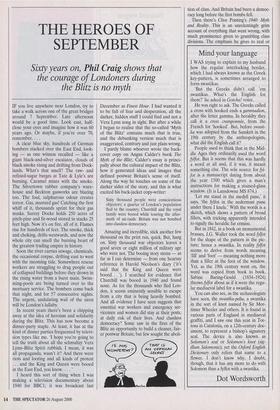Mind your language
I WAS trying to explain to my husband how the regular interlocking border, which I had always known as the Greek key-pattern, is sometimes arranged to form swastikas.
`But the Greeks didn't call 'em swastikas. What's the English for them?' he asked in Gotcha! voice.
He was right to ask. The Greeks called a cross with hooked ends a gammadion, after the letter gamma. In heraldry they call it a cross cramponnee, from the French for 'hooked'. But, before swasti- ka was adopted from the Sanskrit in the 19th century by the anthropologists, what did the English call it?
People used to think that in the Mid- dle Ages they ordinarily used the word fylfot. But it seems that this was hardly a word at all and, if it was, it meant something else. The sole source for fyl- fot is a manuscript dating from about the year 1500 which gives a man's instructions for making a stained-glass window. (It is Lansdowne MS 874.) let me stand in the medyll pane,' it says, 'the fylfot in the nederrnast pane under there I knele.' With the words is a sketch, which shows a pattern of broad fillets, with tricking apparently intended to signify the heraldic fur ermine.
But in 1842, in a book on monumental brasses, J.G. Waller took the word fylfot for the shape of the pattern in the pic- ture; hence a swastika. In reality fylfot seems to derive from words meaning fill' and 'foot' — meaning nothing more than a filler at the foot of the window. Yet, as the 19th century went on, the word was copied from book to book. Sabine Baring-Gould (1834-1924) throws fylfot about as if it were the regu- lar mediaeval label for a swastika.
You can also see, as the archaeologists have seen, the swastika-pelta, a swastika in the sort of knot named by Sir Mor- timer Wheeler and others. It is found in various parts of England in mediaeval graffiti, and I saw one this year in Tor- tosa in Catalonia, on a 12th-century doc- ument, to represent a bishop's signatory seal. The device is also known as Solomon's seal or Solomon's knot (sig- illum Salomonis); yet the Oxford English Dictionary only refers that name to a flower. I don't know why. I doubt, though, that it has any more to do with Solomon than a fylfot with a swastika.
Dot Wordsworth


























































 Previous page
Previous page